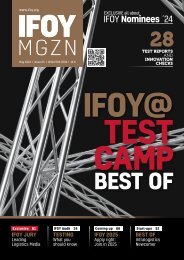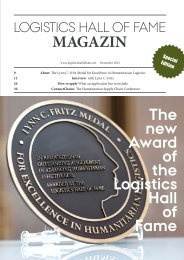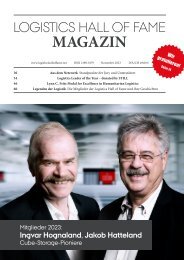Lynn C. Fritz Medal for Excellence in Humanitarian Logistics 2023: International Medical Corps
Create successful ePaper yourself
Turn your PDF publications into a flip-book with our unique Google optimized e-Paper software.
Interview<br />
New global changes<br />
David Alarcon, Vice President Corporate F<strong>in</strong>ance at <strong>International</strong> <strong>Medical</strong> <strong>Corps</strong><br />
What do you see as the biggest challenges<br />
fac<strong>in</strong>g humanitarian organizations?<br />
David Alarcon: The biggest issues <strong>for</strong><br />
humanitarian organizations <strong>in</strong>clude<br />
new global challenges such as the food<br />
crisis, economic <strong>in</strong>stability, extreme<br />
poverty, urbanization, water scarcity<br />
and energy security. In addition, there<br />
is population growth and the impact<br />
of climate change. Another challenge<br />
is the potential <strong>for</strong> highly contagious<br />
local public hazards and epidemics to<br />
develop <strong>in</strong>to pandemics.<br />
What role does politics play <strong>in</strong> the projects?<br />
<strong>Humanitarian</strong> work has become more<br />
dangerous. And more people are suffer<strong>in</strong>g<br />
because aid is not reach<strong>in</strong>g them. There<br />
are other barriers to access, <strong>in</strong>clud<strong>in</strong>g<br />
sanctions-driven export regulations that<br />
also contribute to limit<strong>in</strong>g or delay<strong>in</strong>g access<br />
to vulnerable populations. Another<br />
challenge is bridg<strong>in</strong>g the gap between<br />
emergency aid and development assistance.<br />
The latter is about longer-term<br />
support that strengthens the self-reliance<br />
of those <strong>in</strong> need.<br />
What role does Climate change play?<br />
It is literally br<strong>in</strong>g<strong>in</strong>g entire new regions<br />
to the br<strong>in</strong>k. Extreme weather events can<br />
also lead to mass displacement, as people<br />
migrate <strong>in</strong> search of new sources of food<br />
and water, or safer liv<strong>in</strong>g conditions.<br />
Many humanitarian organizations are<br />
sett<strong>in</strong>g up refugee camps. How good is<br />
this aid?<br />
The conditions <strong>in</strong> the refugee camps are<br />
not always good. This grow<strong>in</strong>g need is<br />
<strong>for</strong>c<strong>in</strong>g humanitarian organizations to<br />
stretch their already scarce resources even<br />
further or make the difficult decision to<br />
cut some programs to better help others.<br />
This leaves vulnerable people without basic<br />
lifesav<strong>in</strong>g services. Because the challenges<br />
humanitarian organizations face every day<br />
are complex and <strong>in</strong>terrelated, efficiency<br />
and effectiveness are paramount. This is<br />
where a system like PIMS can make all<br />
the difference.<br />
What needs to change?<br />
Although many organizations have established<br />
sound processes <strong>for</strong> procur<strong>in</strong>g and<br />
manag<strong>in</strong>g material resources, accurately<br />
assess<strong>in</strong>g needs and avoid<strong>in</strong>g losses <strong>in</strong> the<br />
last mile of the supply cha<strong>in</strong> rema<strong>in</strong>s a major<br />
challenge <strong>in</strong> an uncerta<strong>in</strong> and chang<strong>in</strong>g<br />
environment. A few improvements that<br />
would advance humanitarian logistics<br />
might <strong>in</strong>clude: a more adaptable supply<br />
cha<strong>in</strong>, better preparedness and stronger<br />
partnerships with local organizations,<br />
community support systems and other<br />
actors <strong>in</strong> humanitarian crisis response.<br />
What risks cannot be <strong>in</strong>fluenced by<br />
stronger partnerships?<br />
External supply-cha<strong>in</strong> risks <strong>in</strong>clude<br />
damaged transport routes, disrupted<br />
markets, lack of warehouses, and a lot<br />
more. With so many factors beyond the<br />
control of organizations, it is critical to<br />
build an adaptable supply cha<strong>in</strong> that is<br />
less vulnerable to un<strong>for</strong>eseen challenges.<br />
Is good preparation crucial <strong>for</strong> the success<br />
of projects?<br />
Yes, preparation time is another area<br />
that can be improved. In the run-up<br />
to disaster operations, it is essential to<br />
<strong>in</strong>vest more time <strong>in</strong> build<strong>in</strong>g key partnerships<br />
at the national and local levels.<br />
F<strong>in</strong>ally, build<strong>in</strong>g the capacity of national<br />
and local organizations, and of local<br />
communities, <strong>for</strong> effective supply-cha<strong>in</strong><br />
management will help <strong>in</strong>ternational<br />
aid organizations rely on local staff <strong>in</strong><br />
countries of operation.<br />
Why can’t SCM methods and solutions<br />
from the commercial sector be transferred<br />
to the humanitarian sector?<br />
Best bus<strong>in</strong>ess practices from the commercial<br />
sector cannot always be transferred to<br />
humanitarian logistics because humanitarian<br />
logistics often needs to make last-mile<br />
deliveries <strong>in</strong> locations where commercial<br />
structures are either non-existent or very<br />
limited. Many supply-cha<strong>in</strong> management<br />
technology solutions depend on <strong>in</strong>ternet<br />
availability. Not so PIMS: it elim<strong>in</strong>ates<br />
dependency on <strong>in</strong>ternet connectivity and<br />
cont<strong>in</strong>uous power supply. ∞<br />
Seite 24
















